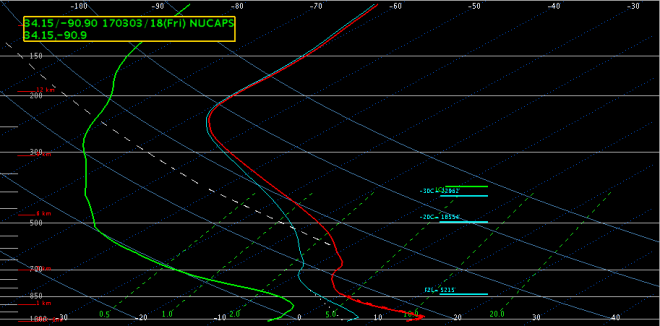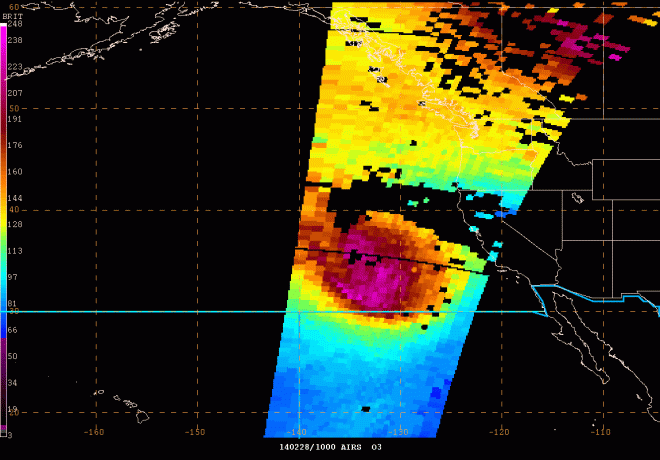By Emily Berndt
SPoRT has been part of a collaborative effort within the Joint Polar Satellite System (JPSS) Proving Ground Sounding Initiative* to develop the capability for 2D display of satellite soundings in the NOAA NWS decision support system (AWIPS). CrIS/ATMS (Cross-track Infrared Sounder/Advanced Technology Microwave Sounder) temperature and moisture soundings are processed through the NOAA Unique Combined Atmospheric Processing System (NUCAPS) and are good quality in clear to partly cloudy regions but soundings are poor quality where cloud cover is over 85% and when precipitating conditions exist. Currently, NWS offices receive NOAA-20 CrIS/ATMS NUCAPS Soundings through the Satellite Broadcast Network for display as vertical soundings and Gridded NUCAPS is the capability to process and view these data horizontally and vertically (Fig. 1). Up until now, Gridded NUCAPS has been pre-processed at SPoRT and provided experimentally to Alaska Region NWS offices and the Hazardous Weather Testbed. The team worked with NOAA/CIRA/MDL to create an AWIPS plug-in to grid the soundings upon arrival and ingest in AWIPS. Gridded NUCAPS has been a successful multi-organizational collaborative R2O/O2R project with a transition to operations in sight. With the official 19.2.1 AWIPS release coming soon SPoRT is finalizing development of training material and an NWS VLab page to highlight the Gridded NUCAPS capability, products, and helpful hints….more information will be forthcoming as these items are completed! NWS offices that are beta testers for new AWIPS releases, such as the Huntsville forecast office will be able to display Gridded NUCAPS with AWIPS 19.2.1-29 prior to the official release.
*including NOAA NWS, Science and Technology Corporation, the Cooperative Institute for Research of the Atmosphere, Geographic Information Network of Alaska, Space Science Engineering Center/Cooperative Institute for Meteorological Satellite Studies, and NOAA/NWS/MDL.

Figure 1. Left: NOAA-20 CrIS/ATMS NUCAPS Sounding Availability in AWIPS and Right: Gridded NUCAPS plan view display of 700 mb Lapse Rates. Demontrates the NUCAPS Soundings are Gridded for plan view and cross section display. Image courtesy of Kevin Fuell (UAH/NASA SPoRT).
Gridded NUCAPS was originally developed to diagnose Cold Air Aloft (CAA; Weaver et al. 2019) and NWS Anchorage Center Weather Service Unit aviation forecasters have benefited from this capability to issue public products regarding CAA. Additionally Gridded NUCAPS has been extensively evaluated at the Hazardous Weather Testbed for assessing the pre-convective environment (Berndt et al. 2017). As part of the JPSS Sounding Initiative, the team of collaborators is exploring new applications for Gridded NUCAPS (e.g., fire weather, turbulence, and icing) and exploring the benefits of the microwave-only NUCAPS Soundings for applications in cloudy regions. A few new capabilities of Gridded NUCAPS include display of fields such as precipitable water to diagnose moist/dry layers in the atmosphere, the Haines Index for fire weather potential (Fig.2), and SPoRT-developed ozone products (e.g., Total Ozone, Ozone Anomaly, and Tropopause Level) to diagnose the potential for tropopause folding and cyclogenesis.
Look for Gridded NUCAPS posters and presentations at the National Weather Association Annual Meeting and the AMS Joint Satellite Conference – both in September!

Figure 2. Top: Example of Haines Index image and icons plotted with Gridded NUCAPS compared to Bottom: GFS Haines Index and Icons for a fire that began on 23 July 2018 near Northway, AK.








































You must be logged in to post a comment.